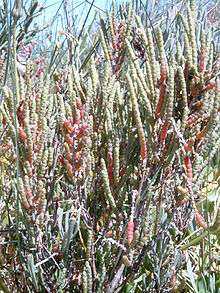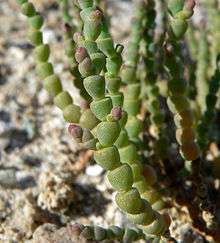Salicornioideae
| Salicornioideae | |
|---|---|
 | |
| Salicornia europaea | |
| Scientific classification | |
| Kingdom: | Plantae |
| (unranked): | Angiosperms |
| (unranked): | Eudicots |
| (unranked): | Core eudicots |
| Order: | Caryophyllales |
| Family: | Amaranthaceae |
| Subfamily: | Salicornioideae Ulbr. |
| Genera | |
|
About 11 genera, see text | |
The Salicornioideae are a subfamily of the flowering plant family Amaranthaceae (sensu lato, including the Chenopodiaceae). Important characters are succulent, often articulated stems, strongly reduced leaves, and flowers aggregated in thick, dense spike-shaped thyrses. These halophytic plants are distributed wordwide.


Description
The Salicornioideae are annual or perennial herbs, subshrubs, or low shrubs. Their stems are glabrous and often apparently jointed. The alternate or opposite leaves are fleshy, glabrous, often basally connate and stem-clasping (thus forming the joints), with missing or short free leaf blades.
The spike-shaped inflorescences consist of alternate or opposite bracts, these are often connate and stem-clasping, sometimes free. In the axil of each bract, there are one to five (rarely to twelve) flowers, free or sometimes fused to each other, to the bract, and to the inflorescence axis. The flowers are usually bisexual (the lateral flowers may be unisexual). The 2-5-lobed perianth consists of two to five connate tepals. There are one or two stamens and an ovary with mostly two stigmas.
In fruiting phase, the perianth remains membranous or becomes spongy, crustaceous, or horny. The fruit wall (pericarp) may be membranous, fleshy, chartaceous, crustaceous, woody, or horny. The seed is disc-shaped, lenticular, ovoid or wedge-shaped. Its surface may be smooth, papillose, reticulate, tuberculate or longitudinally ribbed. The embryo is curved, half-annular or horseshoe-shaped, rarely only slightly curved. In most genera, the seed contains copious perisperm, but a feeding tissue is missing in Salicornia and Sarcocornia.
Photosynthesis pathway
The majority of the Salicornieae species are C3-plants. There is only one species that has developed C4-photosynthesis, Tecticornia indica (syn. Halosarcia indica).[1]
Distribution and Evolution
Plants from the Salicornioideae are found around the world. All are halophytes, growing in coastal or inland saline habitats.
The Salicornioideae originated in Eurasia about 38-28 million years ago, during the Late Eocene/Early Oligocene, and radiated rapidly into its major lineages. Kalidium, the Halocnemum/Halostachys-lineage, Halopeplis, and the Allenrolfea/Heterostachys-lineage were branching off early. Later developed the Arthrocnemum/Microcnemum-lineage, the Halosarcia-lineage (with Halosarcia, Pachycornia, Tecticornia, Sclerostegia, Tegicornia), and the Salicornia/Sarcocornia-lineage. Already in the Middle Miocene, about 19-14 million years ago, all major lineages were present.
Systematics
The taxon was first published in 1849 by Alfred Moquin-Tandon as a tribe Salicornieae within the family Chenopodiaceae.[2] In 1934, Oskar Eberhard Ulbrich raised the taxon to subfamily level and named it Salicornioideae (in: A. Engler & K. Prantl (eds.): Die natürlichen Pflanzenfamilien, ed. 2, Vol. 16c).
The family Chenopodiaceae is now included in Amaranthaceae s.l.[3]
Phylogenetic research supports the monophyly of the subfamily. According to Kadereit et al. (2006), it comprises just one tribe, the Salicornieae. Traditionally two tribes had been distinguished, Halopeplideae and Salicornieae, but these are not monophyletic.
- Tribus Salicornieae: with 11 genera[4] and about 110 species:
- Allenrolfea Kuntze, with 3 species in North and South America.
- Arthrocnemum Moq., with 2-3 species, from Southwest Asia and the Mediterranean region, to western tropical Africa and Macaronesia.
- Halocnemum M.Bieb., with 2 species, from Southern Europe and North Africa to Asia.
- Halopeplis Bunge ex Ung.-Sternb., with 3 species, from the Mediterranean basin and North Africa to Southwest Asia and Central Asia.
- Halostachys C.A.Mey. ex Schrenk, with only one species:
- Halostachys belangeriana in Central and Southwest Asia and southeastern Europe
- Heterostachys Ung.-Sternb.: with 2 species in Central and South America
- Kalidium Moq. (Syn.: Kalidiopsis Aellen): with 6 species in Central and Southwest Asia and Southeast Europe
- Microcnemum Ung.-Sternb., with only one species:
- Microcnemum coralloides in Spain, Turkey, Armenia, and northwestern Iran
- Salicornia L., with circa 15 species worldwide, especially on the Northern Hemisphere, absent in Australia and South America
- Sarcocornia A.J.Scott, with about 30 species worldwide
- Tecticornia Hook f. (inclusive Halosarcia Paul G.Wilson, Pachycornia Hook. f., Sclerostegia Paul G.Wilson, Tegicornia Paul G.Wilson),[5][4] with about 44 species, in Australia, and along tropical coasts of the Indian Ocean to eastern and western tropical Africa.
References
- Gudrun Kadereit, Ladislav Mucina & Helmut Freitag (2006): Phylogeny of Salicornioideae (Chenopodiaceae): diversification, biogeography, and evolutionary trends in leaf and flower morphology. - In: Taxon 55(3), p. 617–642. (for chapters description, distribution and evolution, systematics)
- ↑ Gudrun Kadereit, Thomas Borsch, K. Weising, Helmut Freitag (2003): Phylogeny of Amaranthaceae and Chenopodiaceae and the evolution of C4 photosynthesis. - In: International Journal of Plant Sciences 164(6), p.979.
- ↑ Alfred Moquin-Tandon: Salsolaceae. in: De Candolle (ed.): Prodromus Systematis Naturalis Regni Vegetabilis 13 (2), 1849, p. 144. Masson, Paris. first publication of Salicornieae scanned at BHL
- ↑ Kai Müller & Thomas Borsch (2005): Phylogenetics of Amaranthaceae using matK/trnK sequence data – evidence from parsimony, likelihood and Bayesian approaches, In: Annals of the Missouri Botanical Garden, 92, p. 66-102.
- 1 2 Shepherd, Kelly A.; Wilson, Paul G. (2007), "Incorporation of the Australian genera Halosarcia, Pachycornia, Sclerostegia and Tegicornia into Tecticornia (Salicornioideae, Chenopodiaceae)", Australian Systematic Botany, 20: 319, doi:10.1071/SB07002
- ↑ Shepherd, K.A.; Waycott, M.; Calladine, A. (2004), "Radiation of the Australian Salicornioideae (Chenopodiaceae)--based on evidence from nuclear and chloroplast DNA sequences", American Journal of Botany, 91 (9): 1387, doi:10.3732/ajb.91.9.1387, retrieved 2008-05-26
External links
 Media related to Salicornioideae at Wikimedia Commons
Media related to Salicornioideae at Wikimedia Commons Data related to Salicornioideae at Wikispecies
Data related to Salicornioideae at Wikispecies

